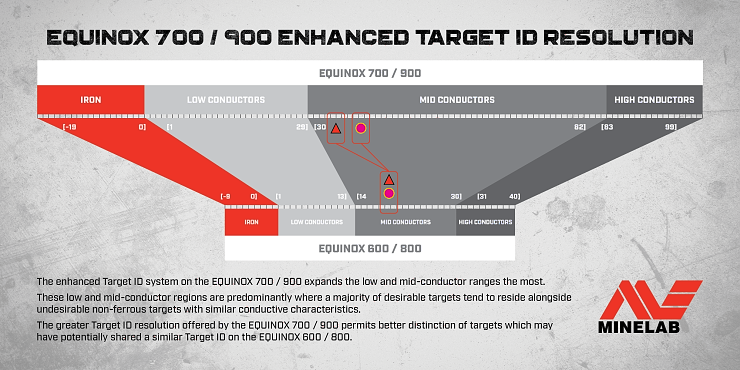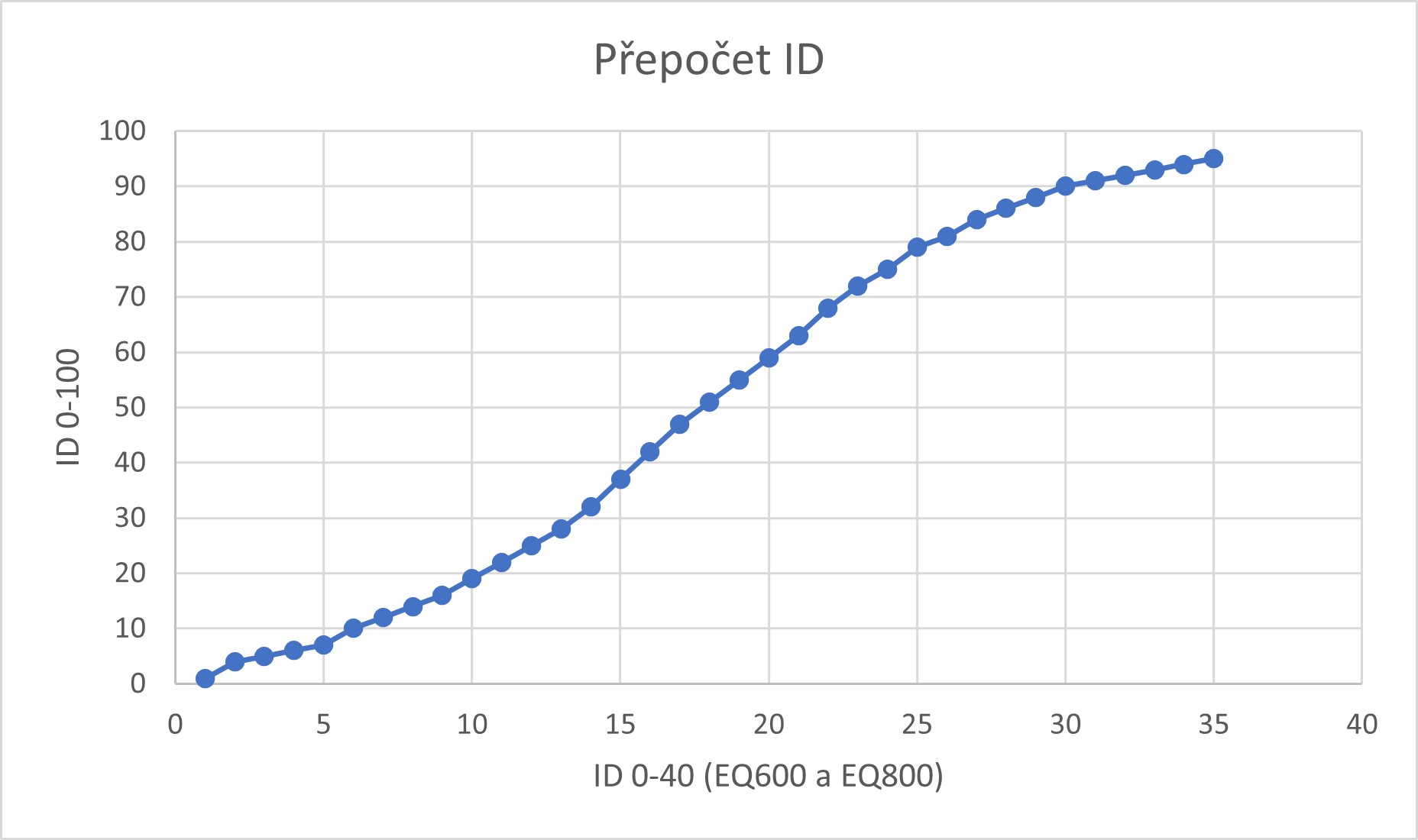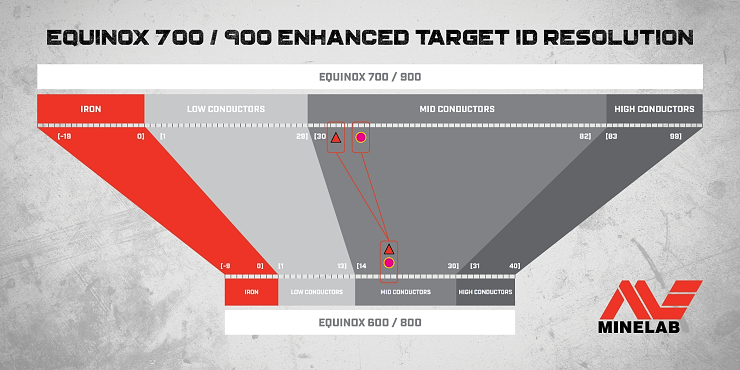Mě osobně nejvíc potěšilo nové vyhodnocení nízkovodivostních cílů. Teď už celkem dobře chytám alobal. Když chci, tak ho pro kontrolu vykopu, ale ID kolem 6-7 je vždycky tohle. 
ID range differences between new and older Equinox and Manticore detectors
Categories: Minelab Equinox 800 and 600 metal detector , Detektor kovů Minelab Manticore , Detektor kovů Minelab Equinox 900 a 700
 The improved target ID system on the Equinox 700 and 900 metal detectors has mostly expanded the area of medium conductive targets (30-82) where the vast majority of targets found fall. Compared to the EQ 800/600 where the same area was based on IDs 14-30 (16 values), the new EQ 900/700 series has the same area based on IDs 30-82 (52 values) making them some of the more desirable and unwanted targets that fell under the same ID on the older EQ series are now easier to distinguish due to the wider range of IDs.
The improved target ID system on the Equinox 700 and 900 metal detectors has mostly expanded the area of medium conductive targets (30-82) where the vast majority of targets found fall. Compared to the EQ 800/600 where the same area was based on IDs 14-30 (16 values), the new EQ 900/700 series has the same area based on IDs 30-82 (52 values) making them some of the more desirable and unwanted targets that fell under the same ID on the older EQ series are now easier to distinguish due to the wider range of IDs.
Recently Minelab released a nice official ID scale comparison chart between the older Multi IQ system (Vanquish and Equinox 800/600 series) and the new scale (Manticore, Equinox 900/700 and X-terra Pro).
I've done something similar right after the new detectors came on the market by simply testing a large number of targets when an official comparison chart was not yet available. So you can see for yourself how much I deviated from the official version.
Comparison chart of ID between Equinox 900 and 800 by Jaccob
 The ID chart was created by testing individual targets between the EQ 900 and EQ 800.
The ID chart was created by testing individual targets between the EQ 900 and EQ 800.
As you can see from my chart and the official version, it's obvious that someone went to the trouble of doing some thinking on this. So there was not just a simple multiplication of the original ID but the whole scale is converted non-linearly with emphasis on the ID values that occur most often.
This has the effect that although in the positive values for non-ferrous metals the conversion ratio is exactly 2.5 (100 values/40values), certain ranges have a higher conversion ratio than others, resulting in a significant refinement in the medium conductivity targets 14-30 on the older range (16 values) which corresponds to IDs 30-82 on the newer range (52 values)-this corresponds to a conversion ratio of 3.25. So it can be said that in this range the new series has a 3.25x more accurate evaluation.
However, there have been changes in other parts of the ID scale as well; for better illustration, the ID scale can be divided into a total of 4 main categories and the corresponding conversion ratio calculated:
- Iron: -9 to 0 (10 values), new range: -19 to 0 (20 values) = conversion ratio :2
- Low conductive targets:1 to 13 (13 values), new series: 1 to 29 (29 values) = conversion ratio: 2.2
- Medium conductive targets: 14 to 30 (16 values), new series: 30 to 82 (52 values) = conversion ratio :3.25
- Highly conductive targets: 31 to 40(9 values), new series :83-99 (16 values) = conversion ratio: 1.8
The above values show where in the ID scale the most significant changes are likely to have occurred and to what extent they are most evident.
Conclusion
After many years of experience, I can say that the new ID scale was obviously designed by someone with experience in search. From my own experience I can confirm that, for example, high IDs (from about 75% ID range +) do not need to be distinguished with such precision and I always look forward to some bigger coppers and faintly hope for a thaler :D.
For small targets that are hard to detect (up to approx. 10-15% of the range for non-ferrous metals) and the ID is also less stable because of this, then logically there is no need to measure the ID with such precision when one can expect lower stability. In contrast, in the area of moderately conductive targets, where most of the average targets found fall, I think this is a nice and positive change.



The article is included in categories:
- Archive of articles > Metal Detectors - Reviews and Tests > Minelab – tests and reviews > Minelab Equinox 800 and 600 metal detector
- Archive of articles > Metal Detectors - Reviews and Tests > Minelab – tests and reviews > Detektor kovů Minelab Manticore
- Archive of articles > Metal Detectors - Reviews and Tests > Minelab – tests and reviews > Detektor kovů Minelab Equinox 900 a 700
Post
Obi asi lepší alobal do odhazováku, než "oči pro pláč"  S ID 7 jsem v pátek kopnul rozlomenou stříbrnou desítku FJ1
S ID 7 jsem v pátek kopnul rozlomenou stříbrnou desítku FJ1 
To jsou ty odkovené desítky, co větčinou praskají mezi prsty. Bylo to na přímce, nebo někde okolo?
Díky za info. Mě by teda nejvíce osobně potěšilo, kdyby tam vrátili procentuální ukazatel baterie. Fakt s tím mám problém. A že to ukazuje dlouho před úplným nabitím 99% je mi u zadku. Já třeba nabíjím s vypnutým displejem, dokud dioda přestane blikat. Psal jsem přímo do Minelabu, jestli by to mohli v updatu dát volitelně, aby si to kdo to chce chce to zapnul. No a po dopovědi, že to předají vývojovému oddělené se na to vys...
Obi, nemám přímku, teda aspoň na detíku ne 
Aha, nevšiml sem si že máš noxe. 
Nathan-Drake: Ahoj, v návrhu to bylo, ale nakonec to tam není. Rozlišení je ale i tak větší než tomu bylo u EQ (počet segmentů). Nevím to jistě a pouze spekuluji, ale myslím, že se to tam nedostalo z jediného důvodu. Jakmile baterie zestárne a tobě se tam při nabíjení neukáže 100%, tak tady bude dost bláznů, kteří nemají tušení jak vlastně fungují baterie a budou psát úplné hámotiny. Takto, když je to v těch segmentech se to prostě dít nebude. V podstatě to tak vidím jako určitou daň za to, jak postupně celkově mizí technické vzdělání celé společnosti. To že e to asi netýká tebe ani nás s Petrem na tom nic nemění.
Elmara: No jo no, ta inteligentní menšina trpí kvůli blbcům, bohužel tomu tak ve světě je. Viz třeba na Slovensku. Nejradši bych stáhnul poslední update a dal nějakému programátorovi, aby mě to upravil.








